

Class: Gastropoda,
Family Muricidae
Family type species: Nucella lapillus (Linnaeus, 1758) An Atlantic species
|
The common west coast gastropod Nucella lamellosa (Gmelin, 1791), common name: Frilled Dogwinkle, is the most variable species to be studied. In the 9 years that I have been seriously collecting and studying this species, I have found a few answers to my questions but have run into even more questions to be answered.
|
Author, Dan Yoshimoto attacking the beach at Lantzville (near Nanaimo) Vancouver Island, British Columbia, Canada |
||
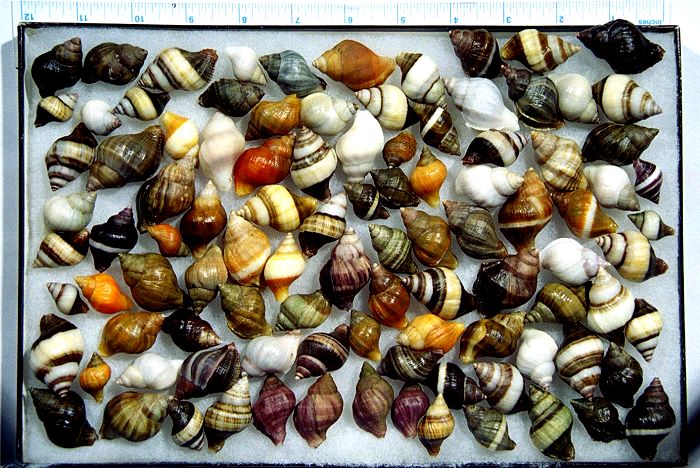 Collection from Airport Beach, Port Hardy, Vancouver Island, Canada |
|||
|
|||
|
Today we have collected
Nucella lamellosa from over 40 locations and have bought, traded and had
donated more than 30 specimens from a number of northern Alaska locations.
10 years later I am still fascinated with what I have learned. In a nutshell,
here are a few facts:
|
|||
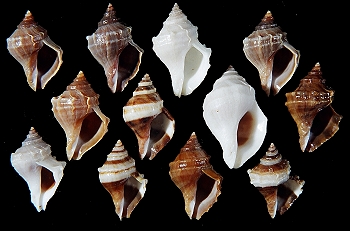 |
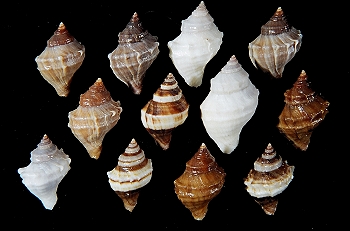 |
||
|
Collection
from
Tent Island, Straits of Georgia, off Vancouver Island, British Columbia, Canada |
|||
|
In 1998 I ran into a rather interesting volume of Trevor Kincaid's "Local Races and Clines in the Marine Gastropod Thais lamellosa Gmelin (A Population Study)". As it was my first "scientific introduction" to the species, and Mr. Kincaid was an expert, I took it for granted that the information was 100% valid, and that I no longer had to do any investigating. WRONG!!! I began to find contradictions in my own encounters that didn't hold up to Kincaid's "facts". I later ran into another scientific abstract by Robert R. Talmadge "Anomalies of Thais lamellosa" (Of Sea and Shore (1) 1973):35, in which he disputed the common conclusions held by many, including Kincaid.
|
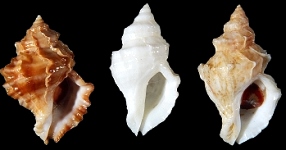 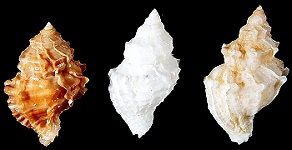
Trio from Vashon Island, Puget Sound, Washington |
||
|
Here are a few assumptions that have been made by many observers: |
|||
| 1. The are 5 forms of Nucella
lamellosa (Dall, 1915-forms "franciscana", "neptunea", "hormica", "cymica" and "sitkana")
|
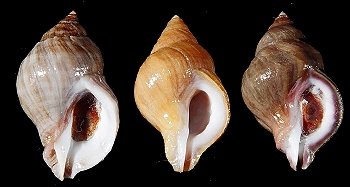 King Salmon Village, Humboldt County, California |
||
2. Smooth forms are only
frilled forms with the frills worn off in their rough surf pounding habitat.
|
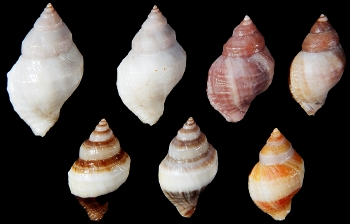 Page Lagoon, Nanaimo, Vancouver Island, British Columbia, Canada |
||
3. Each habitat has its own
color forms.
|
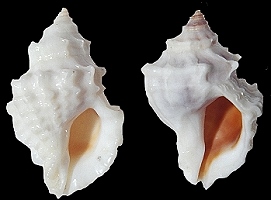 Ucluelet, Barkley Sound, Vancouver Island, British Columbia, Canada |
||
4. Frilled forms are found
in quiet, protected bays and smooth forms are found in rough waters. Both
forms are separated by sandy areas which are not crossed by the species.
|
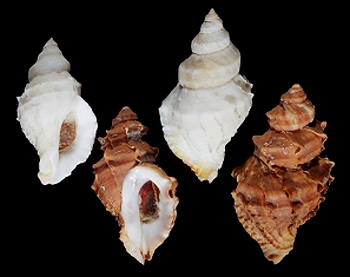 Vashon Island, Puget Sound, Washington |
||
|
In 2005 I gave a short talk and display to the Lost Coast Shell Club (Eureka, California) on the species Nucella lamellosa and from that meeting there came many questions which I could not answer, so I put the questions to the experts and other observers on Conch-L. These are the questions and the responses that we received:
|
|||
|
1. Q. What are the reasons for size differentiation in Nucella lamellosa?
|
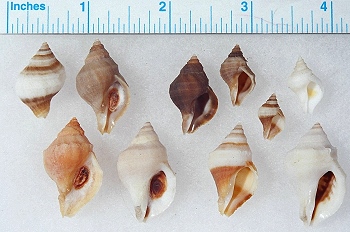 Camano Island, Puget Sound, Washington |
||
|
2. Q. What causes all the color and pattern variations, besides genetics?
|
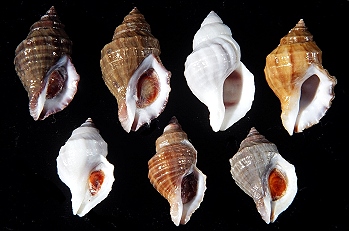 Crescent City, Del Norte Co. California |
||
|
3. Q. Why do some specimens have very thick shells and narrow aperture, while others have thinner shells and more fragile apertures?
|
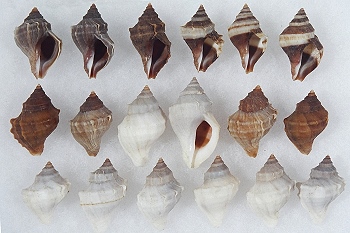 Tent Island, Staits of Georgia, off Vancoouver Island, British Columbia, Canada |
||
|
4. Q. Could the color variations be forms of sexual dimorphism?
|
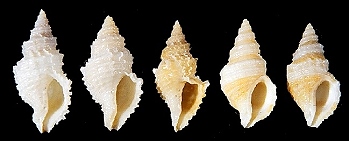 Knight Island, Prince William Sound, Alaska |
||
|
5. Q. Do the egg cases of Nucella lamellosa carry "veligers" that may float around and find new habitats, or are they "Walk away" juveniles, that are limited to their original habitat?
|
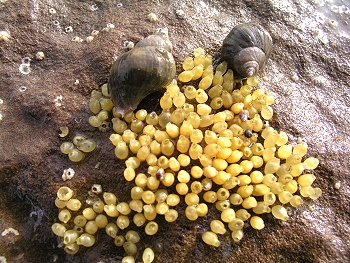 Nucella lamellosa egg cases ?? Suquash Beach, Port Hardy, British Columbia, Canada |
||
| ADDED NOTE: These egg cases are not
from N. lamellosa (is it possible that N. lamellosa eats the
egg cases of other Nucella sp.?). The eggs of N. lamellosa are
tall, thin (not the short, squat eggs in your photo). I believe your
eggs are N. ostrina." Rick
Harbo |
|||
|
6.Q. Why do some specimens have "teeth" , or rows of teeth, in the aperture?
|
|
||
|
Wilson Creek, Del Norte Co., California |
|||
|
Because this species has so many forms, that have confused malacologists in the past, there are many names that have been used for Nucella lamellosa. When first described , it was called Buccinum plicatum by Martyn, in his Universal Conchylium, in 1788 and, in the same year, Chemnitz named it Buccinum compositum. Two years later (1791) the author, Gmelin called it Buccinum lamellosum. All three authors had placed the species in the family Buccinidae. The following are some more synonyms that have been used for this extremely variable species:
|
|||
|
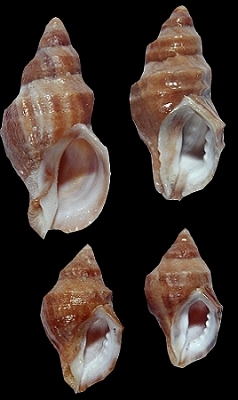 Sunset Bay, Coos Bay, Oregon |
||
|
As there is never an ending to "discovery" my search for more information goes on. Dan Yoshimoto |
|||
|
Silverdale, Dyes Inlet, Puget Sound, Kitsap Co. Washington |
|||
|
References:
Dall, William
Healy Notes on the Molluscan Genus Nucella Inhabiting the Harbo, Rick
M. Shells & Shellfish of the Pacific Northwest Harbour Kincaid,
Trevor Local Races & Clines in the Marine Gastropod Thais Oldroyd,
Ida Marine Shells of the West Coast of North America Stanford San Diego
Society of Natural History Pliocene & Pleistocene Mollusca of Talmadge, Robert R. Anomalies of Thais lamellosa Of Sea & Shore Spring 1973 |
|||
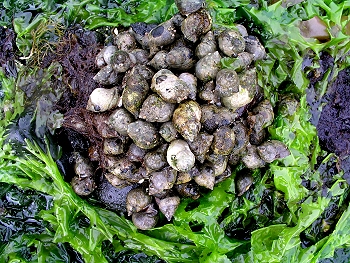 Bear Cove, Port Hardy, Vancouver Island, British Columbia Canada |
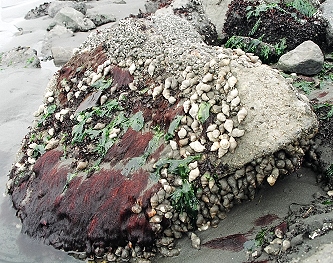 Humbolt Bay, South Penninsula, Humbolt Co., California |
||